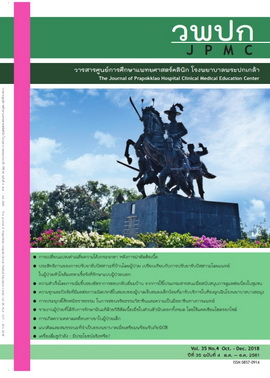The Prevalence and Factors Related to Abnormal Brain Lesions in the Mild Traumatic Brain Injuries of Patients Admitted to the Emergency Room of Banglamung Hospital
Main Article Content
Abstract
Background: Computed tomography (CT) scans of the brain for head injuries at Banglamung Hospital have been continually increasing each year. The factors related to abnormal brain lesions in mild head injuries that can be used as the indications during brain CT scans were surveyed.
Objective: The study’s aim was to determine the prevalence and factors related to abnormal brain lesions in mild traumatic brain injuries at Banglamung Hospital.
Materials and Methods: A prospective, descriptive study was conducted. All 221 mild traumatic brain injury patients were aged 18 and older with GCS ≥ 13, were referred to the Emergency Room (ER) and underwent a brain CT scan.
Results: The mean age was 32.5 years. Most of the subjects were male (69.7%). Positive CT findings were 24.4%. Skull fracture was found to be the most frequent CT finding (59.3%). The factors related to abnormal brain lesions were found to be gender (p = 0.012), alcohol drinking (p = 0.045), loss of consciousness/amnesia (p = 0.002), and vomiting (p = 0.004).
Conclusion: The factors related to abnormal brain lesions include gender, alcohol drinking, loss of consciousness/amnesia and vomiting.
Article Details
References
1. Panjaisri S, Puanpathom N, Veerasan K. Clinical practice guidelines for traumatic brain injury.
Bangkok: Tanapress; 2013.
2. Holm L, Cassidy JD, Carroll LJ, Borg J. Summary of the WHO collaborating centre for
neurotrauma task force on mild traumatic brain injury. J Rehabil Med 2005 ;37:137-41.
3 .American College of Surgeon Committee on Trauma.Head trauma in advance traumatic life
support for doctor.Chicago: ACSCT;2004.
4. Sharif-Alhoseini M, Khodadadi H, Chardoli M, Rahimi-Movaghar V. Indication of brain computed
tomography scan after minor head injury. J Emerg Trauma Shock 2011;4: 472-6.
5. Türedo S, Hasanbasoglu A, Gunduz A, Yandi M. Clinical decision instruments for CT scan in
minor head trauma. J Emerg Med2008;34:253-9.
6 .Waseem M, Iyahen P Jr, Anderson HB, Kapoor K, Kapoor R, Leber M. Islolated LOC in head
trauma associated with significant injury on brain CT scan. Int J Emerg Med 2017;10:30.
7. Haydel MJ, Preston CA, Mills TJ, Luber S, Blaudeau E, DeBlieux PM. Indications for computed
tomography in patients with minor head injury. N Engl J Med 2000;343:100-5.
8. Kamsuk S, Pearkao C. The prevalence and factors related to intracranial hemorrhage in the
mild traumatic rrain injuries of patients admitted to the emergency room of Maharat Nakhon
Ratchasima hospital. The National and Internationa Graduate Research Conference; 2016 Jan
15: Khonkaen: Khonkaen University; 2016. P.656-67.
9. Teadale G, Janett B. Assessment of coma and impaired consciousness.a practice scale.
Lancet 1974;2(7872)81-4.
10. SrisunC.Factors related to abnormal finding of CT brain after minor head injury at krabi
hospital. Reg11 Med J 2015;29:321-6.
11. Hanprakopsuk K. Computed tomography of the brain in acute head trauma in Lampang
hospital.Department of Medical Services Journal2017;85-92.
12. Chartkul M. Factors related to death in trauma patients of advanced EMS in Thailand.
J Prapokkao Hosp Clin Med Educat Center 2014;31:311-26.
13. Dreisbach RH. Handbook of poisoning: diagnosis treatment. 7th ed. California: Lange Medical
Publication, 1976.
14. Koranee R, Aunchai C, Ditsawan A, PomyaiS, VinissornT. A study of blood alcohol level
among cases of traffic accidents in the health service region 3, years 2014-2016.Journal of
Health Science 2017; 26:282-9.
15. Naseri M, Tomasian A, Moghaddas AR. Correlation of CT scan finding with the level of
consciousness in acute head trauma. Iran JRadiol 2005;2:125-9.
16. Syed AT, Lone NA, Wani MA, Bhat AS. Clinical management of patient with minor
headinjuries.Int J Health Sci 2007;1:131-40.
